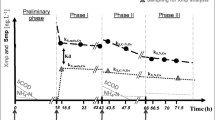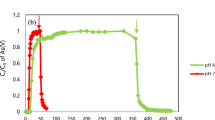Abstract
The present investigation was on the assessment of the fate of 15 organic micro-pollutants (OMPs) under abiotic (predominantly adsorption) and biotic (predominantly bio-sorption/bio-degradation) conditions in columns packed with the aquifer material. The motivation behind this work was to predict the fate of the OMPs during subsurface flow/riverbank filtration (RBF). Columns were packed with aquifer material that was taken out from the laterals of a RBF well, M-15 during its cleaning operation. OMPs that were selected for the study were frequently detected in the river Yamuna, M-15 and other nearby RBF wells. The list included pharmaceuticals and their raw materials, endocrine disruptors, OMPs found in hospital wastes, steroid and personal care products structurally belonging to acrylates, neutral organics, amines, phenols and fatty acids. Among different OMPs, dimethyl maleate, benzoic acid, guanine and lomustine were found to be more mobile than estriol, decanoic acid, 1-tridecanol, 1- eicosanol, triclosan, stearic acid and cetyl alcohol. The mobility depended on the polarity of the OMPs. The retardation factor of non-polar OMPs was more than the polar ones. However, the mobility of the OMPs was considerably restricted in the biotic column. Retardation factors (Rd) for OMPs varied widely in adsorption column from 3 to 772. In biosorption column, Rd ranged from 6 to 1692 showing better removal except for benzophenone. Although, non-polar OMPs may take several years to travel to wells through the sandy aquifer, however, earlier occurrence of some of the polar OMPs cannot be ruled out. Additional treatment for OMPs is must before public distribution.
Graphic abstract





Similar content being viewed by others
Data availability
The datasets generated during and/or analyzed during the current study are available from the corresponding author on reasonable request.
References
Al-Gheethi AAS, Norli I (2014) Biodegradation of pharmaceutical wastes in treated sewage effluents by Bacillus subtilis 1556WTNC. Environ Process 1:459–481
Banzhaf S, Nӧdler K, Licha T, Krein A, Scheytt T (2012) Redox-sensitivity and mobility of selected pharmaceutical compounds in a low flow column experiment. Sci Total Environ 438:113–121
Benotti MJ, Song R, Wilson D, Snyder SA (2012) Removal of pharmaceuticals and endocrine disrupting compounds through pilot and full-scale riverbank filtration. Water Sci Technol Water Supply 12(1):11–23
Bertelkamp C, Reungoat J, Cornelissen ER, Singhal N, Reynisson J, Cabo AJ (2014) Sorption and biodegradation of organic micropollutants during river bank filtration: a laboratory column study. Water Res 52:231–241
Bertelkamp C, Schoutteten K, Vanhaecke L, Bussche-Vanden J, Callewaert C, Boon N, Singhal N, Hoek-Van-der JP, Verliefde ARD (2015) A laboratory-scale column study comparing organic micropollutant removal and microbial diversity for two soil types. Sci Total Environ 536:632–638
Boxall ABA (2008) Fate of veterinary medicines applied to soils. In: Kümmerer K (ed) Pharmaceuticals in the environment. Springer, Berlin, Heidelberg, pp 103–119. https://doi.org/10.1007/978-3-540-74664-5_8
Burke V, Treumann S, Duennbier U, Greskowiak J, Massmann G (2013) Sorption behaviour of 20 wastewater originated micropollutants in groundwater—column experiments with pharmaceutical residues and industrial agents. J Cont Hydrol 154:29–41
Burket SR, Sapozhnikova Y, Zheng JS, Chung SS, Brooks BW (2018) At the intersection of urbanization, water, and food security: determination of select contaminants of emerging concern in mussels and oysters from Hong Kong. J Agric Food Chem 66(20):5009–5017
Calisto V, Esteves VI (2009) Psychiatric pharmaceuticals in the environment. Chemosphere 77(10):1257–1274
Carmody O, Frost R, Xi Y, Kokot S (2007) Surface characterization of selected sorbent materials for common hydrocarbon fuels. Surf Sci 601(9):2066–2076
Dash RR, Mehrotra I, Kumar P, Grischek T (2008) Lake bank filtration at Nainital, India: water-quality evaluation. Hydrol J 16(6):1089–1099
Daughton CG, Ternes TA (1999) Pharmaceuticals and personal care products in the environment: agents of subtle change? Environ Health Perspect 107:907–938
Dsikowitzky L, van der Wulp SA, Dwiyitno D, Ariyani F, Hesse KJ, Damar A, Schwarzbauer J (2018) Transport of pollution from the megacity Jakarta into the ocean: insights from organic pollutant mass fluxes along the Ciliwung River. Estuarine Coastal Shelf Sci 215:219–228
Flemming H-C (1995) Sorption sites in biofilms. Water Sci Technol 32(8):27–33
Grünheid S, Jekel M (2005) Fate of trace organic pollutants during bank filtration and groundwater recharge. In: Proceeding of the 5th international symposium on management of aquifer recharge. ISMAR5, Berlin, Germany
Heberer T, Mechlinski A, Fanck B, Knappe A, Massmann G, Pekdeger A, Fritz B (2004) Field studies on the fate and transport of pharmaceutical residues in bank filtration. Ground Water Monit Remediat 24(2):70–77
Herberer T, Feldmann D, Redderse K, Altmann H-J, Zimmermann T (2002) Production of drinking water from highly contaminated surface waters: removal of organic, inorganic and microbial contaminants applying mobile membrane filtration units. Acta Hydroch Hydrob 30(1):24–33
Kenaga E, Goring CAI (1980) Relationship between water solubility, soil sorption, octanol-water partitioning, and concentration of chemicals in biota. Aquat Toxicol 707(9):78–115
Kieck A, Breuer F, Stumpp C (2019) Column experiments on sorption coefficients and biodegradation rates of selected pharmaceuticals in three aquifer sediments. Water 2020(12):14
Kim SD, Cho J, Kim IS, Vanderford BJ, Snyder SA (2007) Occurrence and removal of pharmaceuticals and endocrine disruptors in South Korean surface, drinking, and waste waters. Water Res 41(5):1013–1021
Kümmerer K (2009) The presence of pharmaceuticals in the environment due to human use—present knowledge and future challenges. J Environ Manag 90(8):2354–2366
Madden JC, Enoch SJ, Hewitt M, Cronin MTD (2009) Pharmaceuticals in the environment: good practice in predicting acute ecotoxicological effects. Toxicol Lett 185(2):85–101
Maeng SK, Ameda E, Sharma SK, Grützmacher G, Amy G (2010) Organic micropollutant removal from wastewater effluent-impacted drinking water sources during bank filtration and artificial recharge. Water Res 44(14):4003–4014
Maeng SK, Sharma SK, Abel CDT, Magic-Knezev A, Amy GL (2011a) Role of biodegradation in the removal of pharmaceutically active compounds with different bulk organic matter characteristics through managed aquifer recharge: batch and column studies. Water Res 45:4722–4736
Maeng SK, Sharma SK, Lekkerkerker-Teunissen K, Amy GL (2011b) Occurrence and fate of bulk organic matter and pharmaceutically active compounds in managed aquifer recharge: a review. Water Res 45(10):3015–3033
Massmann G, Dunnbier U, Heberer T, Taute T (2008) Behaviour and redox sensitivity of pharmaceutical residues during bank filtration—investigation of residues of phenazone-type analgesics. Chemosphere 71(8):1476–1485
Nagy-Kovács Z, László B, Fleit E, Czichat-Mártonné K, Till G, Börnick H, Grischek T (2018) Behaviour of organic micropollutants during river bank filtration in Budapest, Hungary. Water 10(12):1861
Noman E, Al-Gheethi A, Mohamed RMSR, Talip BA (2019) Myco-remediation of xenobiotic organic compounds for a sustainable environment: a critical review. Top Curr Chem 377:17
Onesios KM, Bouwer EJ (2012) Biological removal of pharmaceuticals and personal care products during laboratory soil aquifer treatment simulation with different primary substrate concentrations. Water Res 46:2365–2375
Patterson BM, Shackleton M, Furness AJ, Bekele E, Pearce J, Linge KL, Busetti F, Spadek T, Toze S (2011) Behaviour and fate of nine recycled water trace organics during managed aquifer recharge in an aerobic aquifer. J Contam Hydrol 122:53–62
Pradhan S, Kumar P, Mehrotra I (2015) River pollution: assessment of hydro-philic and phobic nature of persistent organic contaminants. J Env Nano Monit Manag 3:47–54
Qureshi FM, Badar U, Ahmed N (2001) Biosorption of copper by a bacterial biofilm on a flexible polyvinyl chloride conduit. Appl Environ Microbial 67:4349–4352
Royal Society of Chemistry (2015) http://www.chemspider.com/Chemical-Structure.4436352.html. Accessed 4 Feb 2015
Schaffer M, Börnick H, Nödler K, Licha T, Worch E (2012a) Role of cation exchange processes on the sorption influenced transport of cationic β-blockers in aquifer sediments. Water Res 46:5472–5482
Schaffer M, Boxberger N, Börnick H, Licha T, Worch E (2012b) Sorption influenced transport of ionisable pharmaceuticals onto a natural sandy aquifer sediment at different pH. Chemosphere 87:513–520
Schmidt CK, Lange FT, Brauch HJ (2007) Characteristics and evaluation of natural attenuation processes for organic micro pollutant removal during riverbank filtration. http://www.iwaponline.com/ws/00703/0001/007030001.pdf
Seders Dietrich LA, McInnis DP, Bolster D, Maurice PA (2013) Effect of polydispersity on natural organic matter transport. Water Res 47:2231–2240
Tang Y, Yin M, Yang W, Li H, Zhong Y, Mo L, Liang Y, Ma X, Sun X (2019) Emerging pollutants in water environment: Occurrence, monitoring, fate, and risk assessment. Water Environ Res 91(10):984–991
Trček B, Žigon D, Zidar VK, Auersperger P (2018) The fate of benzotriazole pollutants in an urban oxic intergranular aquifer. Water Res 131:264–273
Ullberg M, Lavonen E, Köhler SJ, Golovko O, Wiberg K (2021) Pilot-scale removal of organic micropollutants and natural organic matter from drinking water using ozonation followed by granular activated carbon. Environ Sci Water Res Technol 7:535–548
Worch E (2004) Modelling the solute transport under non equilibrium conditions on the basis of mass transfer equations. J Cont Hydrol 68(1–2):97–120
Worch E, Grischek T, Börnick H, Eppinger P (2002) Laboratory tests for simulating attenuation processes of aromatic amines in riverbank filtration. J Hydrol 266:259–268
Wunder DB, Bosscher VA, Cok RC, Hozalski RM (2011) Sorption of antibiotics to biofilm. Water Res 45:2270–2280
Ying GG, Kookana RS, Kolpin DW (2009) Occurrence and removal of pharmaceutically active compounds in sewage treatment plants with different technologies. J Environ Monit 11:1498–1505
Acknowledgements
The first author would like to thank the Ministry of Human Resources and Development, Government of India for providing research assistantship. She would also like to acknowledge German Academic Exchange Service for providing an opportunity to work in the research project ‘Nachhaltige Trinkwasserversorgung in Uttarakhand’ (no. 56040107) at the University of Applied Sciences Dresden (HTWD), Dresden, Germany. Financial support to carry out field and lab work provided by European Commission in the form of the research project ‘Saph Pani: Enhancement of natural water systems and treatment methods for safe and sustainable water supply in India' (grant agreement no. 282911) is thankfully acknowledged. Authors would also like to thank Dr Ankush Gupta for fruitful discussions during the preparation of the manuscript.
Author information
Authors and Affiliations
Corresponding author
Ethics declarations
Conflict of interest
On behalf of all authors, the corresponding author states that there is no conflict of interest.
Additional information
Publisher's Note
Springer Nature remains neutral with regard to jurisdictional claims in published maps and institutional affiliations.
Rights and permissions
About this article
Cite this article
Mishra, S., Kumar, P. & Mehrotra, I. Fate of 15 wastewater originated organic micropollutants in a sand column. Sustain. Water Resour. Manag. 7, 54 (2021). https://doi.org/10.1007/s40899-021-00535-7
Received:
Accepted:
Published:
DOI: https://doi.org/10.1007/s40899-021-00535-7




